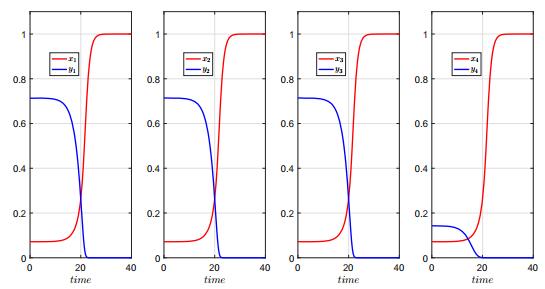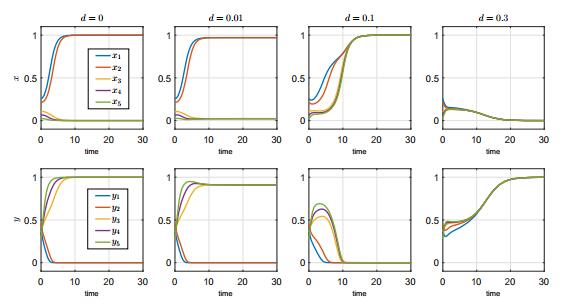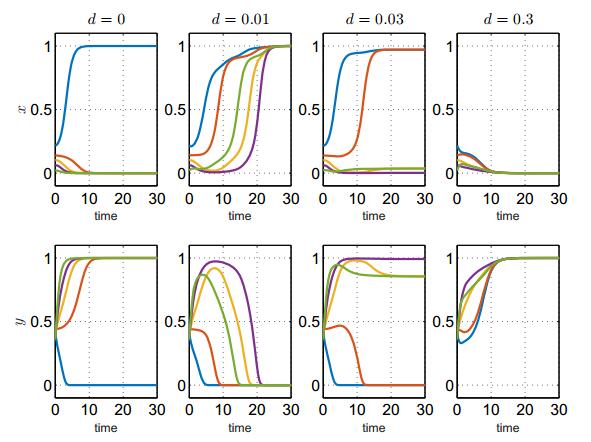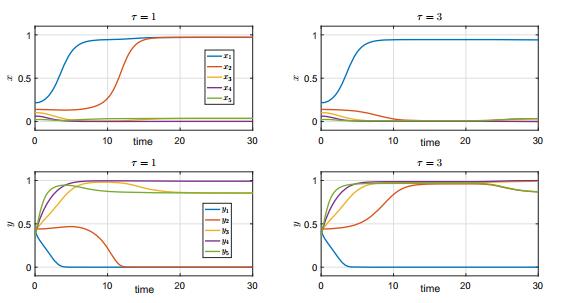In Memory of Geoffrey J. Butler and Herbert I. Freedman
1.
Introduction
Dispersal is one of the most important processes in spatially structured populations. It couples locally interacting populations from all connected patches and results in a metapopulation structure [1]. The movement of dispersing individuals between different habitat patches not only affects local dynamics, but also has global impacts on the persistence and resilience of populations, species coexistence, and ecosystem functions [2]. The role of the dispersal in the metapopulation dynamics has always been an interesting research topic and has attracted much attention. See, for example, [3,4] for experimental reports, [5,6] for work on single species models with dispersal.
When it comes to multi-species models with dispersal, tremendous work has focused on predator-prey systems. To name a few, see [7,8,9,10,11,14,15,16,17,18] and reference therein. Of which, Kuang and Takeuchi [11] found that the dispersal of prey can stabilize and destabilize the homogeneous coexistence equilibrium in a two-patch predator-prey system. Kang et al. [10] showed that in a two-patch predator-prey system with the dispersal of predator only, the dispersal may generate multiple interior equilibria inducing rich bistable phenomena and may also affect the existence of the interior equilibrium leading to the extinction of predator in one patch or both patches. Zhang et al. [18] incorporated a dispersal delay accounting for the travel time from one patch to the other into a two-patch predator-prey model and showed that the dispersal delay may stabilize an unstable coexistence equilibrium. Recently, Mai et al. considered predator-prey models with delayed dispersal over an arbitrary number of patches and showed that the dispersal delay can induce multiple stability switches [12,13].
Compared to predator-prey models, studies on competition models with dispersal are relatively scarce and have focused on dispersal between two patches only [19,20]. To the best of our knowledge, no work has yet incorporated the travel time into the dispersal process for competition models in patchy environments over an arbitrary number of patches. In this work, we shall consider a two-species competition model with one species dispersing between patches. More precisely, we consider two different connection configurations of n patches (where n is an arbitrary positive integer). Since the resulting model would be of high dimension (2n), we assume that the n patches are identical and the dispersal rate is the same to make the analysis possible. Moreover, we incorporate the travel time into the dispersal process. Our objective is to investigate the impacts of dispersal on the dynamics of the multi-patch competition model under two connection configurations.
The rest of the paper is organized as follows. We summarize known results on a single-patch competition model in Section 2. Detailed stability analysis is presented in Section 3 and Section 4 for our multi-patch competition model under two different connection configurations. Numerical simulations are given in Section 5 to explore the impacts of dispersal on the competition outcome. A brief summary is given in Section 6.
2.
The single-patch model
Our multi-patch model is based on the single-patch model described below by a system of two ordinary differential equations
where N1(t) and N2(t) denote the population densities of two competing species at time t, respectively; The parameters r1 and r2 are their corresponding intrinsic growth rates; K1 and K2 are the carrying capacities of N1 and N2, respectively; The parameters b12 and b21 measure the competition strengths N2 on N1 and N1 on N2, respectively.
Setting x=N1K1,y=N2K2,s=r1t,ρ=r2r1,a12=b12K2K1,a21=b21K1K2, we obtain the dimensionless form as follows:
System (2.1) admits four possible equilibria: (0,0), (1,0), (0,1) and (x∗,y∗) with
The dynamics of (2.1) is summarized in the following result (See [21]).
Theorem 2.1. For system (2.1), we have the following conclusions:
(i) The coexistence equilibrium (x∗,y∗) exists if and only if a12>1,a21>1 (strong competition case) or a12<1,a21<1 (weak competition case).
(ii) The coexistence equilibrium (x∗,y∗) is stable if a12<1 and a21<1, and is unstable if a12>1 and a21>1.
(iii) The boundary equilibrium (0,1) is stable if a12>1, and is unstable if a12<1.
(iv) The boundary equilibrium (1,0) is stable if a21>1, and is unstable if a21<1.
3.
The fully connected patchy model
In this section, we assume that the n (identical) habitat patches are fully connected in the sense that individuals from one patch can disperse to all other n−1 patches and the dispersal of one species is at the same rate with a fixed travel time. That is, we consider the following n-patch competition model (in dimensionless form):
where n is the total number of patches. xi and yi denote the densities of species x and y in patch i, respectively, i=1,2,…,n. d>0 is the rescaled dispersal rate. The dispersal delay τ≥0 accounts for the rescaled travel time from one patch to another. τ=0 means the movement between patches is instantaneous, while τ>0 implies that the dispersal is not instantaneous.
For model (3.1), we call an equilibrium (ˉx1,ˉy1,ˉx2,ˉy2,⋯,ˉxn,ˉyn) an x−homogeneous equilibrium if ˉx1≡ˉx2≡⋯≡ˉxn, a y−homogeneous equilibrium if ˉy1≡ˉy2≡⋯≡ˉyn, and a homogeneous equilibrium if it is both an x−homogeneous equilibrium and a y−homogeneous equilibrium.
If a12>1,a21>1 or a12<1,a21<1, then (3.1) always admits a homogeneous coexistence equilibrium
We first give a result on the existence of the coexistence equilibria.
Theorem 3.1. Consider system (3.1). For the weak competition case (i.e., a12<1 and a21<1), system (3.1) admits a unique coexistence equilibrium E∗n, which is homogeneous; while for the strong competition case (i.e., a12>1 and a21>1), besides the homogeneous coexistence equilibrium E∗n, there may exist multiple coexistence equilibria provided that the dispersal rate d is small.
Proof. Suppose that E=(x1,y1,x2,y2,⋯,xn,yn) is a coexistence equilibrium of system (3.1), then there must hold
for i=1,2,⋯,n. Plugging the expression of yi into the first equation of (3.2) immediately yields
Summing (3.3) over i yields
This shows that if E is an x−homogeneous coexistence equilibrium, then x1=x2=⋯=xn=x∗ and hence y1=y2=⋯=yn=y∗. Therefore, E=E∗n is the unique homogeneous coexistence equilibrium provided that a12<1,a21<1 or a12>1,a21>1.
Next we seek for equilibria which are not x−homogeneous. It follows from (3.3) that
Consequently, for ∀i≠j, either xi=xj or xi+xj=1−a12−nd1−a12a21. Without loss of generality, we can assume that there exists an integer 1≤m≤n−1 such that x1=x2=⋯=xm=:α and xm+1=xm+2=⋯=xn=:β with α≠β. Then we have
and
It follows from (3.6) that
We first consider the weak competition case. Note that a12<1 and a21<1, then 1−a12a21>0. In the α−β plane, (3.7) defines a parabola that opens up and intersects the α−axis at α=0 and α=α1:=(1−a12)−(n−m)d1−a12a21. Clearly
This implies that the line given by (3.5) and the parabola defined by (3.7) do not intersect in the first quadrant. A representative sketch of the line and the parabola for the case with 0<α0 is shown in Figure 1. Consequently, system (3.1) does not admit any other coexistence equilibria except for the homogeneous coexistence equilibrium E∗n.
For the strong competition case, a12>1 and a21>1, then 1−a12a21<0 and the parabola defined in (3.7) opens down. In addition, α0>α1>0. From (3.5) and (3.7), we obtain a quadratic equation
Since a12a21−1>0, (a12a21−1)α1+(n−m)d>0 and (n−m)dα0>0, we see that (3.8) admits one or two positive roots if
Equivalently,
Therefore, if d is small satisfying d≤dm for some m=1,2,⋯,n−1, then (3.8) admits one or two positive roots α=αm and if further 1−a21αm>0, then system (3.1) admits multiple coexistence equilibria, which are not x−homogeneous. Furthermore, if d is large enough, say, if d>max{dm:m=1,2,⋯,n−1}, then (3.8) has no roots and hence system (3.1) admits exactly one coexistence equilibrium, which is the homogeneous coexistence equilibrium E∗n.
In the sequel, we focus our analysis on the stability of the unique homogeneous coexistence equilibrium E∗n. Linearizing system (3.1) at E∗n, we see the associated characteristic equations are determined by detJ=0, with J given by
where
It follows from detJ=det(J1+(n−1)Jτ)⋅det(J1−Jτ) that the linear stability of E∗n is determined by the following two characteristic equations
and
where A=a12−11−a12a21, B=ρ(a21−1)1−a12a21. Since a12>1,a21>1 or a12<1,a21<1, we always have A<0 and B<0.
When τ=0, the above two characteristic equations become
and
If a12<1 and a21<1, then all roots of the characteristic equations (3.12) and (3.13) have negative real parts and hence E∗n is locally asymptotically stable; while if a12>1 and a21>1, then the characteristic equation (3.13) has one positive root (since (a12−1)B<0) and consequently, E∗n is unstable.
Next we consider the case with τ>0. The homogeneous coexistence equilibrium E∗n of system (3.1) is stable if all characteristic roots of (3.10) and (3.11) have negative real parts. We regard τ as a bifurcation parameter, as τ increases, the number of roots with positive real parts changes only when there are roots crossing the imaginary axis [22,23,24]. Here we assume that a12−1≠nd. This ensures that zero is not a root of equation (3.11). Thus, we look for a pair of purely imaginary roots of characteristic equations (3.10) and (3.11).
We consider the characteristic equation (3.10) first. Substituting λ=iω with ω>0 into (3.10) and separating the real and imaginary parts, we obtain
Set ω11 and ω12 as
and
Then ω=ω1j (j=1,2) is a feasible root of (3.14) provided that ω1j>0 is well defined. A necessary condition is that Δ1:=(2B(a12−1)+2(n−1)Ad−(A+B)2)2−4B2(a12−1)(a12−1−2(n−1)d)>0. Note that if Δ1>0, then (3.14) may admit at most two positive roots, ω1j, j=1,2.
Further, we have the following lemma.
Lemma 3.2. Suppose at certain τ, the characteristic equation (3.10) has a pair of purely imaginary roots ±iω1j, (j∈{1,2}). Then the following transversality conditions
hold.
Proof. It follows from (3.10) that
Again, by (3.10) we note
Thus, for j=1,2, we have
By the expression of ω1j, we then obtain
The proof is complete.
Similarly, substituting λ=iω into the characteristic equation (3.11), we obtain
If Δ2:=(2B(a12−1)+2(n−1)Ad−(A+B)2−n(n−2)d2)2−4B2(a12−1−nd)(a12−1−(n−2)d)>0, then (3.15) may admit at most two positive roots given by
and
Similar to Lemma 3.2, we can show that the following transversality conditions hold.
Lemma 3.3. Suppose at certain τ, the characteristic equation (3.11) has a pair of purely imaginary roots ±iω2j, (j=1,2). Then
Now we distinguish two cases to discuss the stability of system (3.1) at the homogeneous coexistence equilibrium E∗n.
The weak competition case: a12<1 and a21<1.
We first consider the characteristic equation (3.10). Note that B2(a12−1)(a12−1−2(n−1)d)>0. By the expression of ω11 and ω12, it is seen that (3.10) admits purely imaginary roots only if the following inequality is satisfied
Since 2(n−1)Ad<0, the left hand side of the inequality (3.16) is smaller than 2B(a12−1), while the right hand side of the inequality (3.16) is larger than 2B(a12−1) if a12<1. This implies that the inequality (3.16) can never hold. Consequently, (3.10) does not admit any purely imaginary roots if a12<1 and a21<1.
For the characteristic equation (3.11), we see that (3.11) admits purely imaginary roots only if the following inequality holds
However, using the same manner as for (3.10), we can show that the above inequality never holds. Thus, there are no purely imaginary roots for (3.11) if a12<1 and a21<1. That is, both the characteristic equations (3.10) and (3.11) do not admit purely imaginary roots. Note that the equilibrium E∗n is locally asymptotically stable when τ=0, we see that E∗n remains locally asymptotically stable for all values τ>0.
The strong competition case: a12>1 and a21>1.
We define d1, d2 and d3 as follows:
In the following, we consider four subcases: (ⅰ) d∈(0,d1); (ⅱ) d∈(d1,d2); (ⅲ) d∈(d2,d3); (ⅳ) d∈(d3,∞);
(ⅰ): d∈(0,d1).
In this case we have B2(a12−1)(a12−1−2(n−1)d)>0. Again, a necessary condition for (3.10) to admit purely imaginary roots is that the inequality (3.16) holds. Since 2B(a12−1)<0 and 2(n−1)Ad<0, the left hand side of the inequality (3.16) is less than 0. Consequently, the inequality (3.16) does not hold. On the other hand, for equation (3.11), if d∈(0,d1), then a12−1>2(n−1)d, we have B2(a12−1−nd)(a12−1−(n−2)d)>0. Therefore, (3.11) admits purely imaginary roots only if the inequality (3.17) holds. However, the inequality (3.17) never holds since the left hand side is negative. Therefore, as τ increases, it is impossible for (3.10) or (3.11) to admit purely imaginary roots and hence the equilibrium E∗n remains unstable for all τ>0.
(ⅱ): d∈(d1,d2).
In this case, we have B2(a12−1)(a12−1−2(n−1)d)<0 and B2(a12−1−nd)(a12−1−(n−2)d)>0. Thus, the characteristic equation (3.10) admits a pair of purely imaginary roots λ=±iω11. Since the inequality (3.17) cannot be satisfied in this case, the characteristic equation (3.11) does not admit any purely imaginary roots. Note that sign(d(Reλ)dτ)λ=iω11>0 (Lemma 3.2). This indicates that the equilibrium E∗n remains unstable for all τ≥0.
(ⅲ): d∈(d2,d3).
In this case, we note that B2(a12−1)(a12−1−2(n−1)d)<0 and B2(a12−1−nd)(a12−1−(n−2)d)<0. The characteristic equation (3.10) admits a pair of purely imaginary roots λ=±iω11, and the characteristic equation (3.11) admits a pair of purely imaginary roots λ=±iω21, It follows from sign(d(Reλ)dτ)λ=iω11>0 (Lemma 3.2) and sign(d(Reλ)dτ)λ=iω21>0 (Lemma 3.3) that the equilibrium E∗n remains unstable for all τ≥0.
(ⅳ): d∈(d3,∞).
In this case, we have B2(a12−1)(a12−1−2(n−1)d)<0 and B2(a12−1−nd)(a12−1−(n−2)d)>0. Similar to the case (ⅱ), we can show that equilibrium E∗n remains unstable for all τ≥0.
Summarizing the above analysis, we have the following theorem.
Theorem 3.4. Consider system (3.1). If a12<1 and a21<1, then the homogeneous coexistence equilibrium E∗n is locally asymptotically stable for all τ≥0. If a12>1 and a21>1, then the homogeneous coexistence equilibrium E∗n is unstable for τ≥0.
Remark 3.5 Note that the stability and instability conditions of the homogeneous coexistence equilibrium of the system with n patches are the same as those of the coexistence equilibrium of the single-patch system. This means that the delayed dispersal between patches does not affect the stability and instability of the homogeneous coexistence equilibrium.
We also have the following result on the stability of some boundary equilibria.
Theorem 3.6. Consider system (3.1).
(i) The boundary equilibrium E10=(1,0,1,0,⋯,1,0) is stable for τ≥0 if a21>1 and unstable for τ≥0 if a21<1.
(ii) The boundary equilibrium E01=(0,1,0,1,⋯,0,1) is stable for all τ≥0 if a12>1 and unstable for τ≥0 if a12<1.
(iii) All other equilibria in the form of (0,y1,0,y2,⋯,0,yn) are always unstable, where yi∈{0,1} with ∑ni=1yi<n.
Proof. Linearizing system (3.1) at E10 yields the associated characteristic equations:
Note that a21>1, when τ=0, there are three negative eigenvalues: λ=−1,−1−nd,ρ(1−a21)<0 and hence E10 is stable. If a21<1 and τ=0, E10 is unstable since one of its eigenvalues is λ=ρ(1−a21)>0. When τ>0, substituting λ=iω (ω>0) into (3.18) and separating the real and imaginary parts, we have
Similarly, from (3.19), we obtain
Consequently, both (3.18) and (3.19) do not admit purely imaginary roots. This implies that E10 remains stable for τ>0 if a21>1 and remains unstable for τ>0 if a21<1.
For the boundary equilibrium E01, we have the associated characteristic equations:
When τ=0, it follows from (3.21)-(3.23) that the three eigenvalues are: λ1=1−a12, λ2=1−a12−nd and λ3=−ρ. Thus the boundary equilibrium E01 is stable if a12>1 and unstable if a12<1.
For τ>0, substituting λ=iω (ω>0) into (3.21) and (3.22), respectively, yields, cosωτ=1+a12−1(n−1)d>1 and cosωτ=−(n−1)−a12−1d<−1 provided that a12>1. This is impossible. Thus E01 remains stable for τ>0 if a12>1. Next we consider the case with a12<1. Suppose (3.21) admits a pair of purely imaginary roots λ=±iω. By (3.21), we have
Thus
A direct calculation yields
Note that the eigenvalue obtained from (3.21) is λ1=1−a12>0 when τ=0 and a12<1, and as τ increases, due to (3.24), the characteristic roots cross the imaginary axis always from left to right. This implies, the number of eigenvalues with positive real parts is always increasing and thus there is no possibility for the boundary equilibrium E01 to switch its stability and hence E01 remains unstable for τ>0 if a12<1.
For all other equilibria in the form of (0,y1,0,y2,⋯,0,yn) with yi∈{0,1} and ∑ni=1yi<n. there always exists at least one positive characteristic root λ=ρ>0, thus these equilibria are always unstable. Indeed, we can rearrange the variables in system (3.1) in the order of (x1,⋯,xn,x1(t−τ),⋯,xn(t−τ),y1(t−τ),⋯,yn(t−τ),y1,⋯,yn) and linearize the resulting system. The associated characteristic equations are determined by detJb=0, with Jb given by
where
and
Note that there is at least one yi=0 for some i∈{1,2,⋯,n}. Thus there is at least one characteristic root λ=ρ>0. This completes the proof.
Remark 3.7. Theorem 3.6 indicates that the dispersal does not affect the stability of the two boundary equilibria E01 and E10. If a12>1 and a21>1, then system (3.1) admits at least two stable boundary equilibria, E10 and E01. We should point out that, as demonstrated in Figure 3, besides E10 and E01, system (3.1) may also admit other stable boundary equilibria, which cannot be in the form of (0,y1,0,y2,⋯,0,yn) with yi∈{0,1} satisfying ∑ni=1yi<n. System (3.1) exhibits multi-stability and the competition outcome is initial condition dependent.
4.
The ring-structured patchy model
In this section, we assume that the n identical patches are connected via dispersal of species x in the configuration of a ring structure. That is, we consider the model described by
for i=1,2,⋯,n(n≥3). The definitions of xi, yi, a12, a21, ρ, d, τ are the same as in model (3.1). Here we used the conventional notation: x0=xn, xn+1=x1, y0=yn and yn+1=y1 to close the ring.
Similar to system (3.1), we can show that system (4.1) admits a unique homogeneous coexistence equilibrium E∗n. Linearizing system (4.1) at E∗n, we obtain the corresponding Jacobian matrix in the following form:
with
and Jτ is defined in Section 3. The determinant of Jr is obtained by [25]
Due to the symmetric property of the function cos2kπn, it is seen that system (4.1) has [n2]+1 characteristic equations:
where k=0,1,2,⋯,[n2], and [⋅] is the greatest integer function, A<0 and B<0 are defined the same as in Section 3.
When τ=0, for each k=0,1,2,⋯,[n2], equation (4.2) becomes
Note that if a12<1 and a21<1, then A+B−2d(1−cos2kπn)<0 and B[a12−1−2d(1−cos2kπn)]>0. Thus all roots of the characteristic equation (4.3) have negative real parts for all k and the homogeneous coexistence equilibrium E∗n is stable. If a12>1 and a21>1, then A+B−2d(1−cos2kπn)<0 and B[a12−1−2d(1−cos2kπn)]<0 for k=0. This implies that there is at least one root with positive real part. Thus the homogeneous coexistence equilibrium E∗n is unstable.
We assume that a12−1≠2d(1−cos2kπn) for any k=0,1,2,⋯,[n2], which ensures that λ=0 is not a root of equation (4.2). As in Section 3, substituting λ=iω with ω>0 into (4.2) and separating the real and imaginary parts, for each k, we obtain
where
Similar to Section 3, we can have the following transversality conditions.
Lemma 4.1. Suppose at certain values of τ, for each k, the characteristic equation (4.2) has a pair of purely imaginary roots ±iω(k)±. Then
Next we analyze the stability of the homogeneous coexistence equilibrium E∗n under two cases: (1) a12<1 and a21<1 and (2) a12>1 and a21>1.
The weak competition case: a12<1 and a21<1.
By the expression of ω(k)± and note that (a12−1)2−4d(a12−1)+4d2sin22kπn>0, we can show that, for each k, the characteristic equation (4.2) admits two pairs of purely imaginary roots if the following inequality is satisfied
It follows from a12<1 that 2|B|√(a12−1)2−4d(a12−1)+4d2sin22kπn>2B(a12−1). On the other hand, since 4Ad−(A+B)2−4d2sin22kπn<0, we know that 2B(a12−1)+4Ad−(A+B)2−4d2sin22kπn<2B(a12−1). That is, the inequality (4.4) can never be satisfied. Consequently, no characteristic roots would cross the imaginary axis as τ increases. This means that all characteristic roots have negative real parts. Thus, the homogeneous coexistence equilibrium E∗n remains stable for all τ>0.
The strong competition case: a12>1 and a21>1.
We define three sets as
Note that if k∈M, the characteristic equation (4.2) admits two pairs of purely imaginary roots if the inequality (4.4) holds. However, the inequality (4.4) can never hold since the left hand side of the inequality (4.4) is less than 0. This indicates that the characteristic equation (4.2) does not admit any purely imaginary roots if k∈M.
On the other hand, if k∈N, the characteristic equation (4.2) admits a pair of purely imaginary root λ=±iω(k)+. Note that from Lemma 4.1, sign(d(Reλ)dτ)λ=iω(k)+>0. This indicates the characteristic roots cross the imaginary axis through ±iω(k)+ at certain values of τ from left to right and the number of the characteristic roots with positive real parts is always increasing. Since a12>1, a21>1, the homogeneous coexistence equilibrium E∗n is unstable with τ=0. As τ increases, the are always characteristic roots with positive real parts. As a result, the homogeneous coexistence equilibrium E∗n remains unstable for all τ>0.
The above analysis immediately yields the following result.
Theorem 4.2. Consider system (4.1). If a12<1 and a21<1, then the homogeneous coexistence equilibrium E∗n is locally asymptotically stable for all τ≥0. If a12>1 and a21>1, then the homogeneous coexistence equilibrium E∗n is unstable for τ≥0.
Remark 4.3 Theorem 4.2 indicates that dispersal of one species between patches in the configuration of n ring-structured patches does not change the stability and instability of the homogeneous coexistence equilibrium.
Similar to the proof of Theorem 3.6, we can establish the following result concerning the stability of some boundary equilibria.
Theorem 4.4. Consider system (4.1). The boundary equilibrium E10 is stable for τ≥0 if a21>1 and unstable for τ≥0 if a21<1, and the boundary equilibrium E01 is stable for all τ≥0 if a12>1 and unstable for τ≥0 if a12<1. All equilibria in the form of (0,y1,0,y2,⋯,0,yn) are always unstable, where yi∈{0,1} with ∑ni=1yi<n.
5.
Numerical simulations
In this section, we present some numerical simulations to explore the impact of dispersal on competition outcome. Since we have shown that for the weak competition case, the homogeneous coexistence equilibrium E∗n is the only coexistence equilibrium and is stable, we focus our numerical simulations on the strong competition case (a12>1 and a21>1).
Theorem 3.1 indicates that small dispersal rate d can induce multiple coexistence equilibria in the strong competition case. To illustrate this phenomenon, we take n=4, a12=2>1 and a21=4>1. Then it follows from Theorem 3.1 that there is only 1 coexistence equilibrium if d>max{dm:m=1,2,3}=12√3 and there may exist multiple coexistence equilibria if d∈(0,12√3]. Solving the system of equilibrium equations (3.2), we find that system (3.1) admits 5 coexistence equilibria when d=1/4, which include the unique homogeneous coexistence equilibrium E∗4=(1/7,3/7,1/7,3/7,1/7,3/7,1/7,3/7) and 4 other non-homogeneous coexistence equilibria: (1/14,5/7,1/14,5/7,1/14,5/7,3/14,1/7), (1/14,5/7,1/14,5/7,3/14,1/7,1/14,5/7), (1/14,5/7,3/14,1/7,1/14,5/7,1/14,5/7), (3/14,1/7,1/14,5/7,1/14,5/7,1/14,5/7). If d=1/5, then there are 15 coexistence equilibria. For the ring-structured model, we also observe the existence of multiple coexistence equilibria when d is small. For instance, with n=4, a12=2 and a21=4, system (4.1) admits 9 coexistence equilibria when d=1/4 and 15 coexistence equilibria when d=1/5.
Numerical simulations suggest these coexistence equilibria are all unstable. However, the existence of multiple coexistence equilibria makes transient coexistence in all patches become possible, especially when the initial conditions are very close to some coexistence equilibrium. This transient coexistence of both x and y species in all patches is illustrated in Figure 2, where both species coexist for a short time interval before the y species is driven to extinction in all 4 patches.
Essentially, if a12>1 and a21>1, the unique homogeneous equilibrium E∗n is unstable, both the homogeneous boundary equilibria E10 and E01 are stable, and there may exist other stable equilibria. Next we use numerical simulations to demonstrate that the dispersal rate d does play an important role in determining the competition outcome in the fully connected patchy model. To this purpose, in system (3.1), we take a12=2, a21=4, ρ=2, τ=1 and n=5. We fix initial conditions as (x1(θ),y1(0),x2(θ),y2(0),⋯,x5(θ),y5(0))=(0.26,0.40,0.22,0.46,0.1,0.36,0.06,0.32,0.02,0.28). In the case that the 5 patches are isolated (d=0), as shown in Figure 3, the solution tends to (1,0,1,0,0,1,0,1,0,1) as s→∞. This means the x species wins the competition in patches 1 and 2. If d takes the value d=0.01, the solution tends to a non-homogeneous equilibrium (0.9707,0,0.9707,0,0.0225,0.91,0.0225,0.91,0.0225,0.91) as s→∞. That is, species x and y coexist in 3 patches, species x survives in all 5 patches and species y dies out only in patches 1 and 2. With d=0.1 and d=0.3, the solution tends to the homogeneous boundary equilibria E10 (species x wins competition and species y dies out in all 5 patches) and E01(species y drives species x to extinction in all 5 patches), respectively (See Figure 3).
For the ring-structured patchy model (4.1), the dispersal rate d also plays an important role in determining the competition outcome. For instance, in system (4.1), we take a12=2, a21=4, ρ=2, τ=1 and n=5. We fix initial conditions as (x1(θ),y1(0),x2(θ),y2(0),⋯,x5(θ),y5(0))=(0.36,0.22,0.42,0.14,0.44,0.1,0.40,0.06,0.38,0.02). In the case that the 5 patches are isolated (d=0), as shown in Figure 4, the solution tends to (1,0,0,1,0,1,0,1,0,1) as s→∞, that is, the x species wins competition only in patch 1 and becomes extinct in all other four patches. If d takes the value d=0.01, the solution approaches the homogeneous boundary equilibrium E10 as s→∞ and the x species wins competition in all 5 patches. While at d=0.03 the solution tends to a non-homogeneous boundary equilibrium (0.9711,0,0.9711,0,0.0362,0.8552,0.0021,0.9917,0.0362,0.8552) and the x species survives in all 5 patches, while the y species dies out in patches 1 and 2, and the coexistence of both species occurs in patches 3,4 and 5. When d=0.3, the solution approaches the homogeneous boundary equilibrium E01 indicating the x species dies out in all 5 patches (See Figure 4).
Simulations presented in Figure 5 show that the dispersal delay may also have an impact on determining the competition outcome. When τ=1, the solution of (4.1) approaches the boundary equilibrium (0.9711, 0, 0.9711, 0, 0.0362, 0.8552, 0.0021, 0.9917, 0.0362, 0.8552). If τ is changed to τ=3, the solution approaches another boundary equilibrium (0.9422,0,0.0346,0.8616,0.001,0.9959,0.001,0.9959,0.0346,0.8616) when τ=3. This shows at τ=1, the x species survives in all 5 patches, but the y species only survives at patches 3,4 and 5, and if τ=3, the x species and the y species coexist in all patches except in patch 1, where the y species dies out and the x species survives.
6.
Summary
For a model involving two competing species, we have shown that the dispersal of one species between patches under two configurations of an arbitrary number of patches (fully connected and ring-structured) does not affect the stability and instability of the homogeneous coexistence equilibrium. For the weak competition case, the competition outcome is simple: both species can coexist in all patches. However, if the competition is strong, namely, a12>1 and a21>1, then the competition outcome is complex: for small dispersal rate d, there could exist multiple coexistence equilibria, both the dispersal rate and the dispersal delay have impacts on determining the competition outcome and there could be multiple stable boundary equilibria. The existence of multiple coexistence equilibria leads to the observation of transient coexistence of both species, while the occurrence of multi-stability indicates that the coexistence of both species in some patches (though not in all patches) is possible.
Acknowledgments
The authors wish to thank the anonymous referees for their valuable comments and suggestions. Part of the work was carried out when AM and GS were visiting the University of New Brunswick (UNB), AM and GS wish to thank the hospitality they received from UNB. This work is partially supported by the National Natural Science Foundation of China (No. 11526183, No. 61573016), by China Scholarship Council (No. 201608140214), by the Natural Science Foundation of Shanxi Province (No. 201801D221035), by Yuncheng University (No. YQ-2017003, No. XK-2018033) and by NSERC of Canada.
Conflict of interest
The authors declare that they have no competing interests.
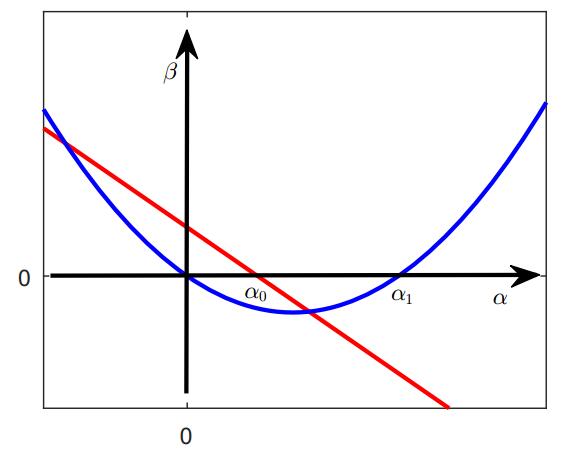









 DownLoad:
DownLoad:
